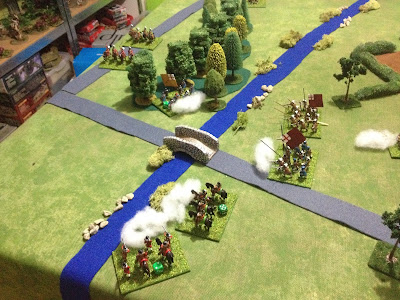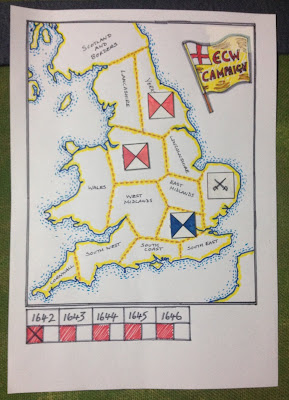These campaign rules will change in 1643 after all regions have declared their support for Parliament or King, and both sides establish marching armies. For me that means there are nine more battles to be fought in 1642. (Note - Scotland and Borders are not to be contested.)
Following Parliament forces gaining control of East Anglia. The Royalists took the safe option to attempt to try and control Lincolnshire, strengthening their hold on the North. As can be seen from the picture Royalists will be able to make two recruitment re-rolls and Parliament one re-roll due to controlling adjacent areas (shown with arrows).
 |
| The next campaign map move |
Lincolnshire recruitment was not so easy for the Royalists and without the support of neighbouring regions they could well have come unstuck. Here is how the recruitment played out for both sides order of battle. The D3 score is in brackets.
Parliamentarian Force
Cavalry = 2 + (3) = 5 units
Infantry = 2 + (2) = 4 units
Dragoons/Commanded Shot = (3) = 2 units dragoons / 1 commanded shot
Artillery/Elite = (1) -1 = 0. This was re-rolled as (3)-1 = 1 artillery and 1 cuirassier
Total units = 14
Royalist Force
Cavalry = 2 + (1). This was re-rolled = 2 + (2) = 4 units
Infantry = 2 + (1). This was re-rolled = 2 + (3) = 5 units
Dragoons/Commanded Shot = (1) = 1 unit of dragoons
Artillery/Elite = (2) -1 = 1 unit 1 artillery
Total units = 11
For more details of the selections see this post.
With forces selected, or should I say recruited, it was time to setup for the tabletop using the battlefield selected using cards which are described in my previous post.
The total number of units a force has is important. The side with the most units is going to be the attacking force and deploy their units on the tabletop second. The steps are:
- Determine the side with most units. In the event they are even, then roll a D3 and the highest score is the attacker and the defending side must remove 1 unit starting with Artillery, Elite, Dragoons, Commanded Shot, Cavalry, Infantry. If scores are tied, both remove a unit and re-roll and keep going until one side rolls higher. Even scores indicate a region where loyalties are torn and desertion could be high.
- The defender choses their side of the tabletop and deploys all units within 2 bounds (12 inches) of the edge.
- The attacker deploys all units within 2 bounds (12 inches) of the opposite edge.
- The defender has the first turn. Allowing them to reposition their forces or advance and take a critical terrain feature.
Finally, I have put up my draft D3 ECW rules on one of the tabs at the top of this blog.
















































